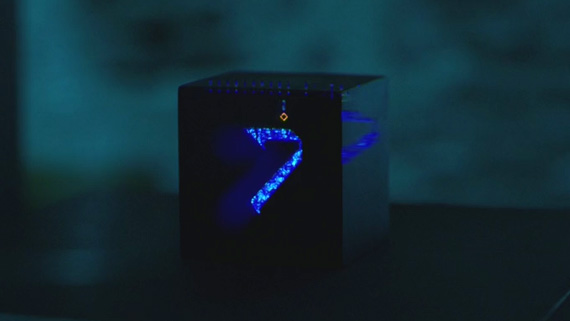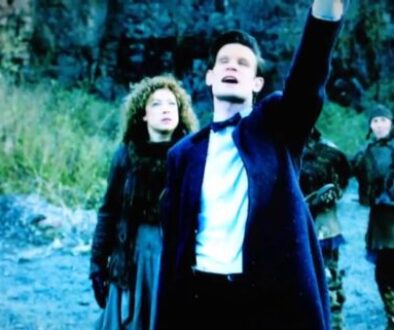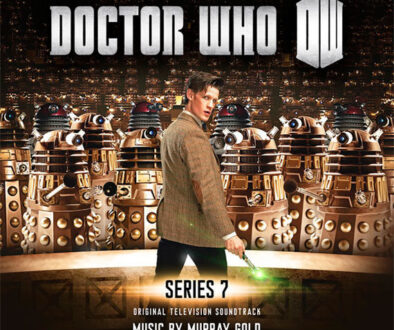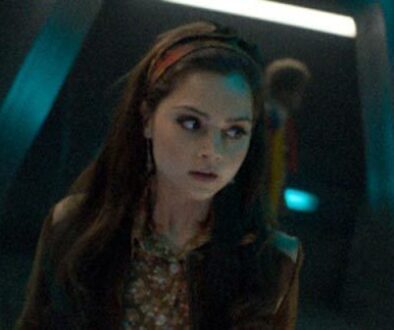Series 7: Part 1 – What Worked, What didn’t
What worked about Series 7: Part 1 and what didn’t? John Hussey gives his overview.
What Worked: The Blockbuster-of-the-Week Format

Steven Moffat’s mad and genius ideas of making each episode of Series 7 based around a blockbuster movie theme really did pay off. It allowed the production team to go all out and make massive episodes in more ways than one. The stories were larger in scale, there weren’t any little episodes. None of the episodes took a breather (except for perhaps ‘The Power of Three,’ at a push) and they all had mad, grand ideas in both design and performance. Not only did this formula give you a variety of stories, but it always gave you big stories. It gave the writers an opportunity to think outside the box and go all out with mad ideas.
The production team also went all out to get some fantastic locations for their blockbuster stories and so decided to take the show to Spain for ‘A Town Called Mercy’ and ‘Asylum of the Daleks’ and then finally New York for ‘The Angels Take Manhattan’. These locations really did the episodes real justice as it made them seem so much larger; movie-scaled, just like Moffat wanted.
What Didn’t Work: Episode Length, No Two-Parters

The downside of the blockbuster-of-the-week format was that the stories became too big for a 45-minute format. Each story in some sense felt like it was cutting short and you were watching the clock constantly, worrying slightly whether everything would be dealt with in the few minutes that remained. If Moffat was dead serious about the episodes being larger and grander, then make the time-frame longer so that more story can be crammed in and precious seconds aren’t wasted in trying to hurry the plot along quicker because time’s running short. If these are blockbuster episodes they should be treated as such. They should be at least an hour long.
I also believe it was madness to get rid of one of Doctor Who’s most vital components; multi-part stories. I was worried that there would come a time in this series were an episode failed because it needed to be a two-parter, and that is exactly what happened. I point to, of course, ‘The Power of Three’. That story was all over the place (which I’ve mentioned many times in the past). It seriously needed to be a two-part story to help spread across all it’s story elements into correct allotted places while at all times allowing everything to get equal attention and screen time.
The final problem of no two-parters is the lack of cliffhangers. Doctor Who grew up on cliffhangers. It’s one of its major components and has been one of its favourable elements since its very beginning back in 1963. It’s such a shame that after 49 years, Moffat has discarded multi-parts. Let’s just hope we have no more incidences like ‘The Power of Three’ in next years’ run.
What Worked/Didn’t Work: Titles of the Week

Now, I still can’t quite get my head around the change in titles and vortex colour every week. I can’t tell whether I like it or hate it. Part of me likes it because it goes well with the whole blockbuster-of-the-week format and makes the show a little more inventive and different. But on the other hand it just looks daft. Why mess around with an already perfect opening sequence and title? Apart from the fact I still think the transition from the title to DW to the TARDIS flying through the vortex is very shoddy. At first I had my absolute doubts because ‘Asylum of the Daleks’ title was rubbish and looked a rip-off of Live at the Apollo’s title. In a turn of events they have slowly got better and I hope they remain to be getting better within the second half of Series 7, but in my heart of hearts, I believe we could have done without this – the sequence was fine just the way it was.
What Worked: Doctor Who?

The whole continuation of last year’s arc ‘Doctor Who’ was reintroduced from the word go. The Doctor, after cheating his death in last years’ final ‘The Wedding of River Song’, has been hiding in the shadows and erasing himself from time and space. Upon being called back into the light by his old enemies the Daleks to help aid them in destroying the dreaded Asylum, he is forgotten again after Oswin erases the Daleks memory of the Doctor’s existence. They scream the words ‘Doctor Who?’ in absolute confusion, creating a very satisfying end to the opener. It has created a very new and interesting area for the Doctor’s character to play in. We have been use to him being a hero blundering in to save the day and being remembered as such, while now he slips in and out of the shadows as a mere ghost, an echo of his old-self. Even Solomon’s computer couldn’t identify him. The Doctor officially no longer exists, which just shows how desperate he was to escape the Silence – showing us a very cold, dark and selfish Time Lord. This shows in some of his adventures, due to his journey’s alone in-between, resulting in him becoming a darker person with less morals and more judgement on himself for his lack of back-bone when it comes to punishing his enemies.
What Worked: Amy and Rory’s Final Character Development

Last year in ‘The God Complex’ we saw the departure of the Ponds. Then in ‘The Doctor, the Widow and the Wardrobe’ the Doctor returned for them. In Series 7 we saw that Moffat had now turned Amy and Rory into one-off companions, with the Doctor picking them up every few months to take them for a trip before taking them back to Leadworth. It was an interesting idea which hasn’t been done before within a companion relationship. The whole process was great to watch and it really helped us to get some final understanding moments within the mind-set of the Ponds and how they reacted to their two different lives.
It was also interesting to see the whole parent scenario thrown in during their final few adventures. Brian Williams was a great addition to their final character development, especially in ‘The Power of Three’ which showed how much he cared about the Ponds. It was such a sad notion to know he sent them off towards their inevitable fate and he would never see them again. At least Chibnall’s short unshot scene showed us that Rory managed to send a letter to his dad explaining their departure and Brian could look after their adopted son.
The divorce scenario in ‘Asylum of the Daleks’ was rather brief but it did pay off and showed us that their love for each other was stronger than ever. The fact that Amy was willing to give up Rory just so he could find someone else and have children was just so selfless and sad. That scene was extremely powerful.
‘The Power of Three’ also showed us how much the Ponds had developed over their time with the Doctor. Amy to begin with was a lonely child filled with mad ideas from a mad childhood, while suffering from some sexual issues. Rory on the other hand was a bumbling nurse and almost the spare knob and TARDIS joke-companion. But after the course of the Series 5 finale and the Series 6 arc, they have both grown and become mature adults who are totally independent. Amy is now intelligent and Rory is now the hero. Their transformation was complete.
What Worked/Didn’t Work: The Monsters: Both Old and New

The Daleks: The Daleks were definitely brought back successfully by Moffat in the series opener. They were no longer survivors. They were now a fully fledged empire with their own Parliament. That was the interesting part; they had a vast room full of Paradigm and Time War Daleks which showcased the sheer power and numbers of the Daleks. To me, it showed they were powerful again; a true threat to the Doctor. The Asylum was also another interesting concept to the story and it added a very dark mythology to the Daleks insanity, by both showcasing the Daleks having a concept of beauty towards hatred and the fact there is a dumping ground full of insane inmate Daleks. The downside though was the lack of Classic Daleks, which I was extremely looking forward to, and the fact the appearance of Skaro caused extreme Timey Wimey ripples in the timeline of the Daleks’ history.
Solomon: Solomon was a great villain and really proved to be a pushing point in the Doctor’s persona from a fun and adventurous character to a dark-hero. He was extremely twisted and completely filled with greed; resulting in him committing mass murder to claim the Silurians valuable cargo. Also he was very willing and happy to use the treat of death against the Doctor multiple times: first with Brian, then with the death of the baby Triceratops and, finally, the kidnapping and sexual threats to Queen Nefertiti. Indeed he was a sick-twisted character which added a great deal to the development of the Doctor’s darker side.
The Gunslinger: The Gunslinger was my favourite part about ‘A Town Called Mercy’, that and the Doctor’s dark side. The design alone really impressed me, along with the electronic voice that was added in post-production. His character had lots of layers, which is uncommon in most villains. The Gunslinger wasn’t simply bad; he was in a sense a tortured soul that had been wronged. Cheated and almost betrayed by his own kind, he was experimented on and turned into a monster to fight a terrible war. Built only to kill, the end of the war meant he would’ve been discarded like an old toy that was no use anymore, so you can’t blame the creature in wanting redemption and vengeance. It was also nice to see that the Gunslinger got a happy ending by becoming the sheriff of Mercy after its long suffering.

The Cubes/Shakri: The Cubes, in my eyes, failed. They came to no real conclusion; almost a complete waste of time. At first they were deemed almost like a threat but slowly became a background ornament while more important story elements took control of the plot. Many things about them was a waste of time, like the different ways they killed or tortured people, the strange nurse things, the girl in the hospital and finally the experiments on the spaceship. The Shakri was another wasted opportunity as their involvement within the invasion was too brief and we didn’t learn enough about them, despite the fact them being the mastermind behind the Cube invasion. All we can pray for is another encounter and perhaps then we will get further and better knowledge about their dark schemes and purpose.
The Weeping Angels: If a villain’s return isn’t better than the first time then it’s not doing a very good job. Well I can definitely say that Moffat has used his brilliant creation with great care and imagination on both of their returns. In their third full-on appearance they were still chilling and terrifying and like in ‘The Time of Angels/Flesh and Stone’ new additions to their mythology were added. The re-establishing of any statue can be an Angel and their cruel act of time-displacement certainly made their threat seem that bit higher and extremely dark. Also the Cherub Angels were also really freaky, especially because of their innocent childish laugh. The one downside that came to mind about the Angels was the Statue of Liberty. It wasn’t really explained and it wasn’t much of a threat which was disappointing because I naturally assumed it would have been the centre of the Angels plans.
What Definitely Worked: Oswin and The Ponds’ End

Oswin was a nice little extra treat for the grand opener and in all honesty a massive shock and surprise. Jenna-Louise Coleman did well in portraying the one-off character (unless of course it turns out that it is the same character in the second half) especially since she was trapped in that one room. She was funny, feisty and a little bit sexy and above all extremely intelligent. She was indeed a “computer-wiz”. The shocking thing about her character was the reveal that she was actually a Dalek and the whole time we saw her was all in her own mind because she locked herself away from the horrific truth of her reality. Oswin was like a double shock surprise and a great one at that. I’m really looking forward to Jenna’s return in the 2012 Christmas Special.
Amy and Rory’s departure was everything Moffat promised and more. It was fantastic and 100% sad. Not only did they die twice in a dramatic and heartbreaking way, we got a reassurance scene in the middle which made you cry even more when they did go. The fact Rory didn’t get to say goodbye was the awful part of it. After all his adventures with the Doctor and his gradual acceptance as a proper companion onboard the TARDIS, he didn’t get to say goodbye to the Doctor who had become a good friends to him. Amy’s departure scene was just as bad and because of Karen and Matt’s superb acting skills, it just made you weep even further. The fact the Doctor couldn’t do anything to prevent the event which was set in stone was what truly made it all the more devastating.
Agree/Disagree? Sound off in the comments below.








